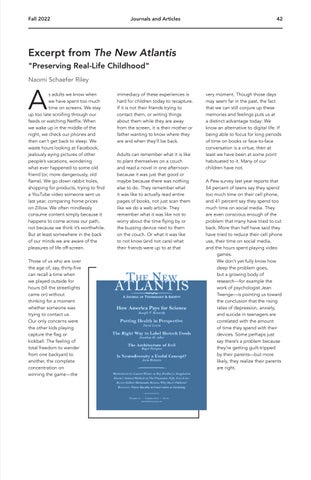Fall 2022
Journals and Articles
42
Excerpt from The New Atlantis "Preserving Real-Life Childhood" Naomi Schaefer Riley
A
s adults we know when we have spent too much time on screens. We stay up too late scrolling through our feeds or watching Netflix. When we wake up in the middle of the night, we check our phones and then can’t get back to sleep. We waste hours looking at Facebook, jealously eying pictures of other people’s vacations, wondering what ever happened to some old friend (or, more dangerously, old flame). We go down rabbit holes, shopping for products, trying to find a YouTube video someone sent us last year, comparing home prices on Zillow. We often mindlessly consume content simply because it happens to come across our path, not because we think it’s worthwhile. But at least somewhere in the back of our minds we are aware of the pleasures of life off-screen. Those of us who are over the age of, say, thirty-five can recall a time when we played outside for hours (till the streetlights came on) without thinking for a moment whether someone was trying to contact us. Our only concerns were the other kids playing capture the flag or kickball. The feeling of total freedom to wander from one backyard to another, the complete concentration on winning the game—the
immediacy of these experiences is hard for children today to recapture. If it is not their friends trying to contact them, or writing things about them while they are away from the screen, it is their mother or father wanting to know where they are and when they’ll be back. Adults can remember what it is like to plant themselves on a couch and read a novel in one afternoon because it was just that good or maybe because there was nothing else to do. They remember what it was like to actually read entire pages of books, not just scan them like we do a web article. They remember what it was like not to worry about the time flying by or the buzzing device next to them on the couch. Or what it was like to not know (and not care) what their friends were up to at that
very moment. Though those days may seem far in the past, the fact that we can still conjure up these memories and feelings puts us at a distinct advantage today: We know an alternative to digital life. If being able to focus for long periods of time on books or face-to-face conversation is a virtue, then at least we have been at some point habituated to it. Many of our children have not. A Pew survey last year reports that 54 percent of teens say they spend too much time on their cell phone, and 41 percent say they spend too much time on social media. They are even conscious enough of the problem that many have tried to cut back. More than half have said they have tried to reduce their cell phone use, their time on social media, and the hours spent playing video games. We don’t yet fully know how deep the problem goes, but a growing body of research—for example the work of psychologist Jean Twenge—is pointing us toward the conclusion that the rising rates of depression, anxiety, and suicide in teenagers are correlated with the amount of time they spend with their devices. Some perhaps just say there’s a problem because they’re getting guilt-tripped by their parents—but more likely, they realize their parents are right.






